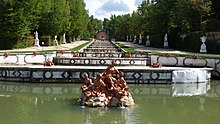Palacio Real (La Granja)
The Palacio Real La Granja de San Ildefonso is a former summer residence of the Spanish kings. The castle is located in San Ildefonso in the Segovia region , about 60 kilometers northwest of Madrid . It is considered the Spanish Versailles .
history
Since the late Middle Ages, there has been a small pilgrimage chapel on the site of the castle , dedicated to St. Ildefons ( Spanish: "San Ildefonso"). She was looked after by the Hieronymite monks , who also ran a monastery here . A small country house (span. Granja ) later belonged to this monastery , in which Philip V was once lodged and who fell in love with the landscape there. In 1720 the king bought the land around the monastery and the country house from the Hieronymite monks and began planning the construction of a castle.
Initially, a simple four-wing castle was built around the former cloister of the monastery , which was executed by Teodoro Adremáns. In this palace building, the future palace church was integrated backwards to the corps de logis , so that it formed the mutual facade on the garden side. In 1723 work had progressed so far that the royal couple could move into their new residence . As early as 1724, the king found his new palace too small and in the following years a total of four wings, two on the left and two on the right of the main building, were added, which now expanded the width of the palace on the garden side to 153 meters and the floor plan of the Building the approximate shape of a capital H. The courtyards of honor created by the new extensions were soon referred to as the coach yard and the horseshoe yard , depending on their use and shape .
In 1734 the Italian architect Filippo Juvarra was appointed to the Spanish court. He had previously directed the planning for the new building of the Palacio Real in Madrid , which was destroyed by fire . For the castle of La Granja he redesigned the facades and gave them their current appearance.
The castle area was constantly rebuilt, expanded and enlarged with outbuildings in the following centuries, the palace was repeatedly inhabited by the Bourbons and was long one of the most popular residences of the royal family. Due to its location at more than 1,200 meters above sea level, the summers here were fresher than in the capital. The dictator Francisco Franco also visited the castle regularly.
Two fires devastated parts of the palace in the 20th century: a fire broke out in 1918 that destroyed more than half of the roofs and some outbuildings; the subsequent restoration work takes almost ten years. In 1991, another fire destroyed Franco's former private rooms.
The palace of La Granja now serves as a museum in which extensive art treasures of the Spanish kings are on display. The castle is especially known for its important tapestries .
park
The palace has a 600-hectare castle park , which is one of the largest in Spain. On the garden side of the Corps de Logis there is a parterre delimited by hedges with a large cascade. The adjoining areas are divided into Boskette . A lake above the water basin, called El Mar , which serves as a water reservoir, lies in a south-easterly direction in a large forest area.
The baroque garden of La Granja was modeled on the park of Versailles. The earlier abundance of water in the nearby mountains allowed the operation of numerous water arts and the great cascade. Due to the long drought in Spain, some basins are no longer filled with water. Numerous newly planted trees are sick as a result of the lack of water.
A 2.7-hectare vortex labyrinth is located in two merged bosettes , which was laid out around 1725 according to a plan by Antoine-Joseph Dézallier d'Argenville .
Impressions of the parks
See also
literature
- Juan A. Hernández Ferrero: Palacios reales del Patrimonio Nacional . Editorial Lunwerg, Barcelona 1997, ISBN 84-7120-218-2 .
- German translation: Spanish royal palaces. Evidence of a national history . Könemann, Cologne 1999, ISBN 3-8290-2231-X .
Web links
Coordinates: 40 ° 53 ′ 51 ″ N , 4 ° 0 ′ 16.5 ″ W.









